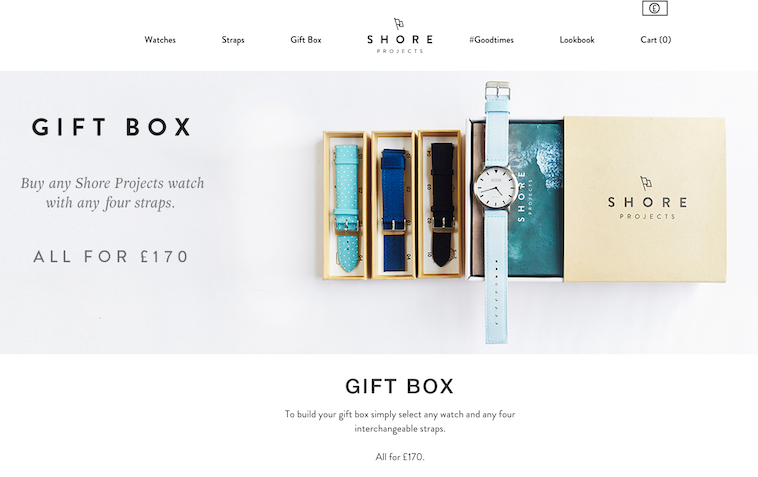We just announced the winners of our fifth annual Build a Business Competition, honouring entrepreneurs that sell the most during a two-month period.
It takes a lot of work and expertise to build a high-functioning ecommerce website, and sometimes merchants can’t do it on their own. That’s why we created the Shopify Partners Build a Business Competition — to honour the designers, developers, marketers, and consultants who contribute to the success of the winning stores.
This year, we’re proud to announce that one of the winning Build a Business shops was made possible by a Shopify Partner, making them the official winner of the Shopify Partners Build a Business Competition.
And the winner is...
Congratulations to twotwentyseven London! Founder Nathan Bentley worked alongside Shore Projects on their Shopify website, helping create a high-converting website that enabled the watch company to win the competition. And that means twotwentyseven London gets to take home our grand prize of $10,000 USD.
To learn more about Shore Projects, take a look at the Shopify Ecommerce Blog’s winners announcement.
We took some time to ask Nathan what it was like to work with Shore Projects. Here’s what he shared with us.
How did you first make contact with the winning shop?
We'd previously worked with the owners/investors of Shore Projects on a number of other projects. When they needed help setting up an ecommerce presence, they came to us for a friendly chat, and we recommended Shopify as the perfect platform for them. Having used Shopify on many other ecommerce builds, we knew that it would be the right fit for them and their products.
What impressed you about Shore Projects?
We have a great relationship with the Shore Projects team — and of course, it helps that we love the design of the watches and straps (in fact, if you come to our offices, you'll find most of the team wearing them). Working with the Shore team has been a real breath of fresh air. They've got a great eye for design, an ability to pick up and understand the technical side of things quickly, and are always open to new ways of working.
What impressed us most about the Shore team is that they aren’t technology-phobic. They love to find ways to use technology to make life easier, whether for their business, or for their customers — and because of this, they are happy for us to pitch new and exciting ways to make the Shore site better and better.
What was your favourite part about working with Shore Projects?
Aside from getting to wear the watches ourselves? We've really enjoyed the brainstorming sessions with the Shore team. No matter what problem we face, we've always found an inventive solution, and always because we're able to freely and openly discuss ideas with the team. We're also really lucky to have been involved with Shore from the start, and it's a joy to see their business evolve and expand. The latest series of watches (Project 3) are fantastic, and we're privileged to have been a part of that.

What was the most difficult obstacle you overcame while working on the store?
Working with multiple currencies. With other sites, we've been lucky enough to take advantage of the live currency conversion tools supplied by Shopify (along with the useful scripts originally supplied by Caroline Schnapp) to show equivalent conversion from other currencies to GBP. In this case, however, the business plan from Shore required us to be able to take orders in GBP, AUD, EUR and USD. Being able to take orders in a number of different currencies isn't something Shopify supports natively, but with a bit of ingenuity, a multi-store setup, and after getting very intimate with Shopify's incredibly versatile API, we were able to overcome this hurdle and make both our client and Shore customers happy.
The gift box builder turned out to be pretty complex too — in order to extract all the combinations of watch faces and straps, we ended up pulling product data from the store via the API, then compiling this into a special JSON feed for use with the gift box builder. This in turn uses the AJAX API to fill the basket, before redirecting them to the checkout. Again, some of the issues we encountered were things like having to add items sequentially, instead of all at once. A quick read of the AJAX documentation helped us solve this problem, and we were quickly underway once more.
What lessons did you learn along the way?
We discovered an amazing community behind Shopify, as well as a ton of resources that can help when you're stuck. Our advice to anyone starting out with Shopify would be to learn to use the Shopify documentation and forums — there's a plethora of helpful snippets, guides and people that can help improve your site.
Learning the finer details of the Liquid templating language has really helped too — the "Shopify Cheat Sheet" by Mark Dunkley is a great place to start, but the best thing to do is experiment and not be afraid of breaking something. If you’re technically inclined, it’s also worth taking a look at how Liquid works under the hood — it’s great that Shopify has opened up so much of their code for public viewing, especially when you can see what makes the cogs turn inside. We’ve been able to make our Liquid templates work a bit harder behind the scenes because of that.
If you could go back and do one thing differently, what would it be?
Like all website builds, there are always aspects we'd love to go back and simplify. With Shore, we're fortunate enough that we're given the freedom to explore new ways of working, and revisit functionality we feel doesn't work as well as we'd hoped. Of course, the Shopify platform is constantly evolving and adding new features too, so we'd love to go back and take advantage of them.
We’re still using an external site to pull in products from the Shopify API and format them into a usable JSON array for things like the gift box builder. If we get the time, I’d like to go back and find a way to remove this requirement. It’d be one less thing to go wrong, and would mean we’d better benefit from Shopify’s excellent SLA (no more restarting servers at 3AM!).
What is your favourite feature of their shop?
The gift box functionality is one of our favourite sections. It started out as a temporary seasonal Christmas feature, but soon became a permanent fixture on the site. Being able to see all the combinations of watch faces and straps in incredible detail is a massive selling point. Not only can you see the great quality of the product, but it also helps you decide which combinations really work for you — something that isn't always possible online.

Were you aware that Shore was a frontrunner in the competition?
No, it came as a complete surprise to us — but an amazing one at that!
What do you think it is about Shore that made them so successful?
I think it's the combination of a great product, on a stylish and easy-to-use site, with great content. Just having a great product isn’t enough if the site doesn’t communicate the quality to the customer — we use a combination of product zoom on mouseover (using the great elevateZoom plugin by elevateweb), and an interactive watch strap carousel so you can see all the combinations of watch faces and watch straps easily and in detail. It means we have a lot of product photos, but it’s well worth it for the experience alone.
Of course, Shopify makes it easy for us to forget about the technical aspects of running a complex ecommerce store, and get on with building attractive pages for brilliant products.
Any fun facts about the shop you’d like to share?
Some of the more technical 'behind the scenes' stuff that has been built (like a weekly reporting tool that keeps management and investors in the loop with sales figures) was done as a result of bets between the sales team and the developers. Thankfully the stakes are quite small (usually a crisp five-pound note), but it helps keep the team on their toes — no one likes losing a bet!
What do you plan to do with your prize?
We're already working on a new Shopify store for an internal project of our own — we'll be investing the prize money into building that new store. Who knows, maybe we'll be in the running again next year when the competition launches — keep an eye on us!
What tools do you use most when working with clients or on their sites?
To start with, we find pen and paper works well to sketch up simple wireframes that help convey ideas to clients, as well as ensuring our thought processes are correct and aligned. By keeping the sketches simple, we can ensure that we don't get too caught up in the finer design aspects before we've nailed the user journey.
Following that, we use some pretty standard tools like Photoshop and Sublime Text to craft up the pages, as well as some bespoke scripts that take advantage of the excellent Shopify API to do the grunt work on some of the more monotonous tasks.
What books and blogs do you read to keep up to date on the industry?
All of our designers and developers have their own selection of favourite blogs (including this one) from which they take inspiration, as well as sharing their best finds on our own internal message board and IRC channel.
Primarily, we'd recommend a visit to Web Field Manual. It's got a wealth of links to some incredible sites, both for inspiration, and for improving your coding techniques.
Here's a few more of our personal favourites:
- Smashing Magazine
- Codrops
- Dribbble
- Behance
- The Noun Collective
- Formagramma
- Tuts+ Web Design
- CodyHouse
- siteInspire
- Little Big Details
What is your advice to other Shopify Partners working with clients?
Spend the time to really get to know your clients, their products, and their priorities/needs. The deeper the understanding of their business, the better the end product you build for them will be. We've eaten our client's products, drank their teas, coffees, beers and ciders, and have even done spinning classes and hiked country trails with them — it's helped every time.
As an example, I was once on-site with a client discussing how their physical store was represented on their ecommerce site, working on the front desk to make sure I really understood the problems the team faced, when I discovered their till system took several dozen keypresses to make a simple purchase of a bottle of water. I was able to pull out my iPad, fire up Shopify POS, and demo it within minutes (including the receipt printers and cash drawers which connected automatically).
We've eaten our client's products, drank their teas, coffees, beers and ciders, and have even done spinning classes and hiked country trails with them — it's helped every time.
By the end of the day we’d swapped out their old EPOS system for Shopify POS, saving them money, and making the lives of the front-of-house team much easier. We’d have never done this if we hadn’t taken the time to really get involved in their business.
Of course, when you're sitting back with a frosty beverage and amazing food whilst planning a site, it's sometimes easy to forget you're working!









